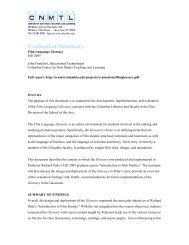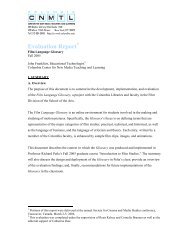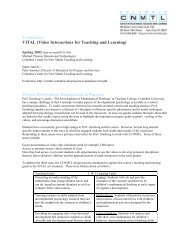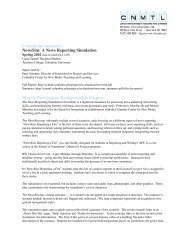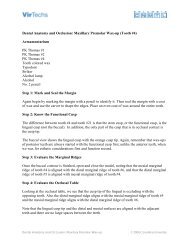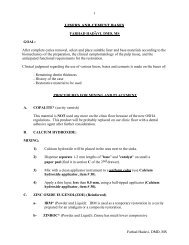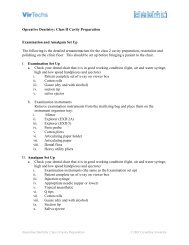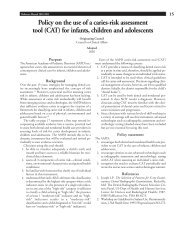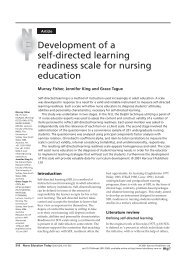Read the summary of this session - Columbia Center for New Media ...
Read the summary of this session - Columbia Center for New Media ...
Read the summary of this session - Columbia Center for New Media ...
Create successful ePaper yourself
Turn your PDF publications into a flip-book with our unique Google optimized e-Paper software.
UNIVERSITY SEMINAR IN NEW MEDIA TEACHING AND LEARNING<br />
SEPTEMBER 23, 2004<br />
E: Face -- Integrating Electronic Discussion Postings with Face-2-face Teaching<br />
Pr<strong>of</strong>essor Sunil Kumar<br />
Department <strong>of</strong> Social Policy, London School <strong>of</strong> Economics and Political Science<br />
By way <strong>of</strong> introduction, Pr<strong>of</strong>essor Kumar explained that <strong>the</strong> impetus <strong>for</strong> developing <strong>the</strong> use <strong>of</strong><br />
electronic postings was to maximize <strong>the</strong> seminar <strong>for</strong>mat <strong>for</strong> both teacher and student. He briefly<br />
reviewed <strong>the</strong> types <strong>of</strong> seminar <strong>for</strong>mats encountered at his university He noted that typically, <strong>the</strong>y<br />
involve a student presenting topics or a paper and posing questions <strong>for</strong> discussion.<br />
Pr<strong>of</strong>essor Kumar <strong>the</strong>n outlined <strong>the</strong> shortcomings <strong>of</strong> <strong>this</strong> traditional face-to-face seminar <strong>for</strong>mat<br />
under specific conditions, <strong>for</strong> example, uneven student presentations. He identified <strong>the</strong>se as<br />
problems stemming from <strong>the</strong> traditional seminar <strong>for</strong>mat and his school's nationally diverse<br />
student body, and <strong>of</strong>fered a process chart leading from <strong>the</strong>se problems to <strong>the</strong>ir respective<br />
outcomes, especially <strong>for</strong> good students.<br />
Pr<strong>of</strong>essor Kumar next discussed various ways <strong>of</strong> integrating electronic postings into <strong>the</strong><br />
traditional seminar <strong>for</strong>mat. He enumerated <strong>the</strong> benefits <strong>of</strong> using electronic postings prior to faceto-face<br />
teaching and characterized <strong>the</strong>m as ways to fix <strong>the</strong> problems <strong>of</strong> <strong>the</strong> traditional <strong>for</strong>mat. He<br />
concluded that <strong>the</strong> strengths <strong>of</strong> <strong>this</strong> alternative <strong>for</strong>mat (<strong>the</strong> traditional face-to-face plus electronic<br />
postings) are that seminars are less likely to turn into mini-lectures, and consequently, <strong>the</strong><br />
learning experience is enhanced. Pr<strong>of</strong>essor Kumar also contrasted <strong>the</strong> above-described benefits<br />
with <strong>the</strong> "debits" <strong>of</strong> <strong>this</strong> use <strong>of</strong> electronic postings.<br />
Following his presentation, Pr<strong>of</strong>essor Kumar detailed his experience <strong>of</strong> using electronic postings<br />
in <strong>this</strong> way. He illustrated with examples from his seminar's bulletin board. In particular, he<br />
demonstrated <strong>the</strong> kinds <strong>of</strong> initial queries he poses to students, and how he scaffolded <strong>the</strong>ir
esponses. He explained that <strong>the</strong> process intends <strong>for</strong> students to build <strong>the</strong>ir critical thinking<br />
skills.<br />
Similarly, Pr<strong>of</strong>essor Kumar described how he uses students' electronic postings in class. For<br />
example, he said, he <strong>of</strong>ten reiterates or o<strong>the</strong>rwise draws from points that students have made<br />
<strong>the</strong>rein. He noted that his use <strong>of</strong> electronic postings differs depending on <strong>the</strong> class. In any case,<br />
he emphasized, <strong>the</strong>re must be variety in <strong>the</strong> tasks assigned to students week-to-week <strong>for</strong><br />
electronic postings to engage <strong>the</strong> students. Pr<strong>of</strong>essor Kumar concluded that electronic postings<br />
enhance <strong>the</strong> content <strong>of</strong> class and/or <strong>the</strong> discussion <strong>of</strong> various topics by providing an avenue <strong>for</strong><br />
introducing additional sources <strong>of</strong> in<strong>for</strong>mation and knowledge. His students are nationally<br />
diverse, Pr<strong>of</strong>essor Kumar explained, so <strong>the</strong>y have much to contribute in <strong>this</strong> respect.<br />
Pr<strong>of</strong>essor Kumar <strong>the</strong>n presented a second project, namely, a web-based research "map" <strong>for</strong> <strong>the</strong><br />
writing <strong>of</strong> baccalaureate, masters and doctoral <strong>the</strong>ses. Pr<strong>of</strong>essor Kumar explained that <strong>the</strong> map<br />
intends to show how <strong>the</strong> different elements <strong>of</strong> a research project work toge<strong>the</strong>r to <strong>for</strong>m a unified<br />
process; <strong>for</strong> example, how to get from a topic <strong>of</strong> interest to a workable research question.<br />
Pr<strong>of</strong>essor Kumar reasoned that <strong>the</strong> research and writing process is an intricate one deserving <strong>of</strong><br />
such a guide. He noted that it is designed <strong>for</strong> self-study since <strong>the</strong>re is no <strong>for</strong>mal structure to<br />
support students through <strong>the</strong> <strong>the</strong>sis requirement.<br />
Pr<strong>of</strong>essor Kumar fur<strong>the</strong>r explained that <strong>the</strong> research map works in conjunction with a research<br />
process web site, which expands upon <strong>the</strong> map. He demonstrated how <strong>the</strong> map can be used as an<br />
index to <strong>the</strong> material contained at <strong>the</strong> site; or alternatively, <strong>the</strong> material may be perused from top<br />
to bottom as in a traditional document. By clicking on different parts <strong>of</strong> <strong>the</strong> map, students can<br />
access descriptions <strong>of</strong> <strong>the</strong> corresponding research components in <strong>the</strong> <strong>for</strong>m <strong>of</strong> Power Point slides.<br />
Pr<strong>of</strong>essor Kumar said that he has used <strong>the</strong> research map as a teaching tool <strong>for</strong> <strong>the</strong> last two years.<br />
Although difficult to quantify, he said it has had a positive impact. For instance, Pr<strong>of</strong>essor<br />
Kumar noted that due to <strong>the</strong> lack <strong>of</strong> structure <strong>for</strong> <strong>the</strong> final research project, students tended to<br />
write descriptive (as opposed to analytical) <strong>the</strong>ses. He said that <strong>the</strong>ir work is stronger in terms <strong>of</strong><br />
<strong>the</strong> individual research components. However, he would still like to refine <strong>the</strong> digital
environment so as to improve <strong>the</strong> learner’s ability to integrate <strong>the</strong> stages and view <strong>the</strong> process as<br />
a recursive one. Pr<strong>of</strong>essor Kumar concluded that <strong>the</strong>re is <strong>the</strong>re<strong>for</strong>e still some need <strong>for</strong> face-t<strong>of</strong>ace<br />
instruction in <strong>the</strong> research and writing process.<br />
With respect to <strong>the</strong> usefulness <strong>of</strong> such a resource to <strong>the</strong> writing program at <strong>Columbia</strong>, Pr<strong>of</strong>essor<br />
Kumar suggested that it <strong>of</strong>fers students <strong>the</strong> opportunity to collaborate with each o<strong>the</strong>r through <strong>the</strong><br />
research/writing process. At <strong>the</strong> very least, he added, it provides a measure <strong>of</strong> in<strong>for</strong>mal support,<br />
which graduate students especially need. Thus, it has a potential audience that is quite wide.<br />
Pr<strong>of</strong>essor Kumar <strong>of</strong>fered some evidence <strong>of</strong> <strong>this</strong>, noting that <strong>the</strong> number <strong>of</strong> students registering<br />
<strong>for</strong> access to <strong>the</strong> map has grown each year since its introduction, and currently stands at about<br />
400.




